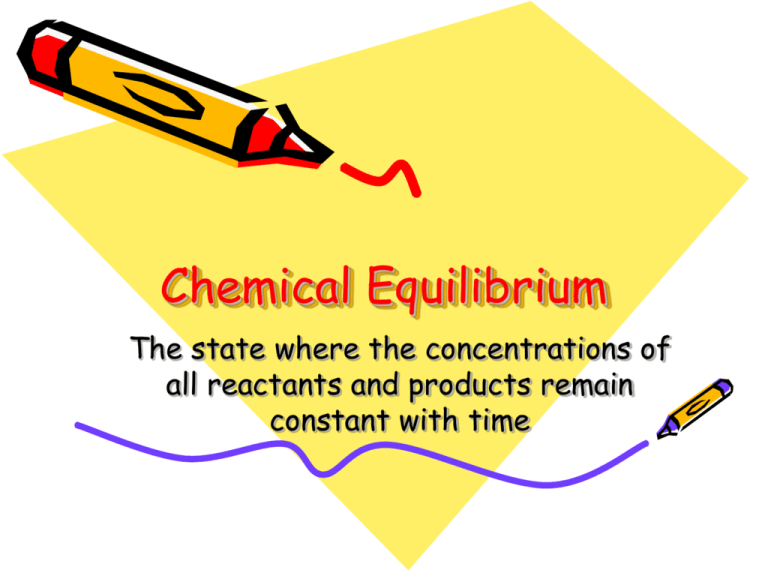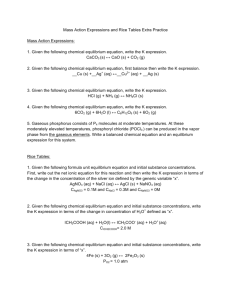Chemical Equilibrium
advertisement

Chemical Equilibrium The state where the concentrations of all reactants and products remain constant with time How is “equilibrium” different than chemical reactions we have studied so far? • For stoichiometry calculations, we assume reaction goes to completion. • In calling a compound “soluble,” we assume that ions remain dissociated in water: NaCl + H2O Na+(aq) + Cl-(aq) • In a closed vessel, a chemical reaction achieves a state of equilibrium, where concentrations of both reactants and products remain constant over time. Equilibrium = Dynamic • Reactants convert continually to products AND • Products continually revert to reactants • Due to molecular collisions • Forward and reverse RATES are equal The Equilibrium Expression • • • • Given the following reaction at equilibrium: 2A(g) + 3B(g) 2C(g) + 4D(g) This is the equilibrium expression: Keq = [C]2[D]4 [A]2[B]3 • Keq is the equilibrium constant. • Include concentrations for products or reactants ONLY for gases and aqueous solutions. • Liquids and solids are not included because their concentrations do not change. Most Familiar Equilibrium Example: Water • Water molecules split other water molecules into hydrogen ions and hydroxide ions to a small extent. • This is called auto-ionization, or selfionization of water. • This reaction is reversible and does not go to completion in the forward direction. It reverses itself after only a few ions are formed. • The equilibrium expression for this equation: Kw = [H3O+][OH-] Most Familiar Equilibrium Example: Water H2O H3O+(aq) + OH- (aq) • Kw = 1.0 x 10-14 [OH-][H3O+] = 1.0 x 10-14 * • Since the K value is so small, this indicates that not very many ions form before the equation reverses itself and begins to form the molecules of water again. • In pure water and in aqueous solutions, there are both H+ and OH• ACIDS: [H3O+] > [OH- ] • BASES: [OH-] > [H3O+] . *Includes concentrations for products or reactants ONLY for gases and aqueous solutions Equilibrium Positions • At a given temp, there is only one value of K but an infinite number of possible equilibrium positions. • Eq. position defined by the concentrations that satisfy the equilibrium expression. • Equilibrium position – Depends on initial concentrations (aqueous or gaseous mixtures) – Never depends on amount of pure solid or liquid in the system Problem: Calculating K At 127º C, [NH3] = 3.1 x 10-2 M [N2] = 8.5 x 10-1 M [H2] = 3.1 x 10-3 M Find K for the Haber process. N2(g) + 3H2(g) 2NH3 (g) K = [NH3]2 = (3.1 x 10-2 M)2 [N2][H2]3 (8.5 x 10-1 M)(3.1 x 10-3 M)3 K = 3.8 x 104 (no units) Problem: Calculating K for Reverse Reaction At 127º C, [NH3] = 3.1 x 10-2 M [N2] = 8.5 x 10-1 M [H2] = 3.1 x 10-3 M Find K for 2NH3 (g) N2(g) + 3H2(g) K’ = [N2][H2]3 =(8.5 x 10-1 M)(3.1 x 10-3 M)3 [NH3]2 (3.1 x 10-2 M)2 K’ = 2.6 x 10-5 (no units) Visualizing Equilibrium • Try this activity to see effects of changing concentrations on the equilibrium of a system: http://cheminfo.chem.ou.edu/~mra/CC LI2004/ERGBN.htm Important Points about K • 1. 2. 3. • For a balanced equation, Kc: is constant at a given temperature changes if the temperature changes does not depend on initial concentrations Kc’ is the equilibrium constant for the equation written in reverse, and is the reciprocal of Kc Reaction Quotient, Q • Is a measure of reaction progess Q < Kc • Uses same form as Kc • Also called mass action expression Q > Kc • Concentrations not necessarily at equilibrium Q = Kc Forward reaction dominates until equilibrium is achieved Reverse reaction dominates until equilibrium is achieved System at equilibrium Application: Using Kc to find concentrations PCl3(g) + Cl2 ( g) PCl5 (g) At a given temp, this reaction occurs in a 1.0-L container with 0.25 mol PCl5 and 0.16 mol PCl3. At equilibrium, what is the concentration of Cl2? Kc = [PCl5] = 0.25 =1.9 [Cl2][PCl3] [Cl2]0.16 [Cl2]=0.25 (0.16)(1.9) = 0.82 M Q: Problem provides concentrations of species and K 1. Write the equilibrium expression, using the letter Q instead of K 2. Substitute concentrations (or pressures ) into the equation to find Q 3. Compare Q to K: Put these two values on a number line to easily state the direction of equilibrium Q is used for specific instances of known concentrations. Predicting shift based on Q: If Q < K, there are more reactants than there will be at equilibrium, so reaction shifts right. Number line trick: Q value …….K value → Point to K, (right shift) More predicting equilibrium shift based on Q: If Q > K, there are more products than there will be at equilibrium, so reaction shifts left. Number line trick: K value …….Q value Point to K ← (left shift) RICE Table • A more common application gives initial concentrations and Kc and you must find the equilibrium concentrations. • Make a table showing the reaction, initial concentrations, change and equilibrium concentrations to solve this problem. • You will often need to use the quadratic formula to solve these, so refresh your memory on your calculator. a If Kc = 49.0 at a given temp, and 0.400 mol of each reactant are placed in a 2.0 L container, what concentrations of all species are present at equilibrium for A + B C + D? [A]o = [B]o = 0.400 mol/2L = 0.200 M [C]0 = [D]0 = 0 M R A+ B I 0.200 M 0.200 M 0 0 C -X -X +X +X E (0.200 –x)M (0.200 –x)M +X M +X M KC = 49.0 = C+ (x)(x) (0.200 –x) (0.200 –x) D A rare occasion without quadratic formula Kc = 49.0 = (x)(x) (0.200 –x) (0.200 –x) 7.00 = x/(0.200-x) x = 1.40 – 7.00 x 8.00x = 1.40 X = 0.175 [A] = [B] = 0.200 – 0.175 = 0.025 M [C] = [D] = 0.175 M LeChâtelier’s Principle When a system at equilibrium is disturbed by application of stress, it attains a new equilibrium position that minimizes the stress. "If stress is applied to a system at equilibrium, the system will tend to readjust so that the stress is reduced." Pressure and volume effects on equilibrium • Pressure and volume do not affect concentrations of solids and liquids because they are not particularly compressible. • Recall the universal gas law for ideal gases: PV = nRT so P = nRT V Pressure and volume at constant temperature • If volume decreases, partial pressure of a gas increases and therefore concentration (n/V) increases. • If number of moles of gas are the same on both sides of equation, then equilibrium is unaffected. • If volume decreases, equilibrium shifts toward side of equation with FEWER moles gas because the concentration of that side has increased: • A(g)<->2B(g) Kc = [B]2 so Q would be >Kc [A] Proof • If decrease V, shift to side of FEWER moles gas: • A(g)<->2B(g) If equilibrium V = 2 L and V2 = 1L, [A]eq = .5 M and [B] eq = 1 M Kc = [B]2 = 1 = 2 [A] .5 At V2, [A]eq = 1 mol/1L and [B] eq = 2mol/1L Q = [B]2 = 22= 4 [A] 1 Q >Kc so equilibrium shifts back to side of reactants, WHICH IS SIDE WITH FEWER MOLES! Pressure and volume effects on equilibriumSUMMARY Change Q vs K Volume ↓ Pressure ↑ Q > Kc Volume ↑ Pressure ↓ Q < Kc Shift Toward smaller # gas moles Toward larger # gas moles







